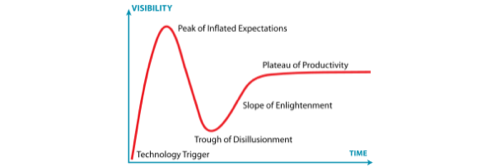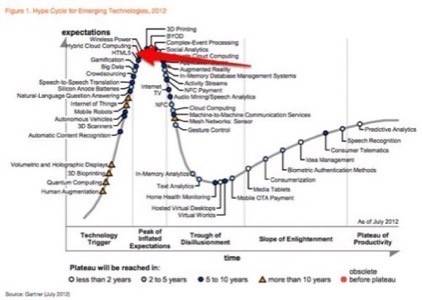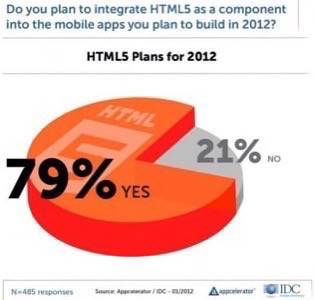
Is HTML5 a distant dream or a here-and-now lifeline for the mobile Web? A recent report from research firm Gartner predicted that this collection of next-gen Web technologies is still five to 10 years from becoming a suitable basis for businesses. But developers are moving forward apace, and HTML5-enabled apps will become ubiquitous within months, not years.
Gartner has been producing its Hype Cycle report since 1995 and it has had a very good track record of predicting how technologies would evolve over time. For instance, its analysis of Near Field Communications this year was spot-on. But it may have missed the mark on HTML5 this time around. The report shows HTML5, an evolving standard that specifies the way Web pages and applications should be rendered by a browser, still ascending the slope the “peak of inflated expectations.” After that, it will need to drop into the “trough of disillusionment” before climbing the “slope of enlightement” in five to 10 years.

HTML5 is a tricky technology to forecast because of its sweeping implications for the developer community. The fact is that developers have embraced the emerging standard and, given the breakneck pace of the tech industry, they have no incentive to wait for it to solidify.
Many skeptics point out that the standard will not be officially ratified by the World Wide Web Consortium (W3C, a standards-making organization for Web-based technology) until 2014. The final ratification of HTML5 may not come until 2022. That timeline is an eon in terms of Web development, especially considering that HTML4 was ratified in 2000.
On the other hand, most developers do not care a wink about when and how the W3C ratification for HTML5 comes. The W3C is a cumbersome organization, run more like a federal government agency than fast-moving innovator. There are benefits and drawbacks to how the W3C operates (one being that it does not rush to validate technologies that are destined to fall into “flavor of the month” categories) but most developers are not looking to the W3C for guidance on how they build their applications. The fact is that HTML5 capabilities are available for developers now, not three to 10 years from now.
Every company that makes a browser has been hard at work to support HTML5 capabilities. That includes Google Chrome, Apple Safari, Microsoft Internet Explorer and Mozilla Firefox as well as smaller browser makers like Dolphin and Opera. Facebook has become a big supporter of HTML5 and introduced a testing suite called Ringmark to test browser capabilities earlier this year.
The evolution of HTML5 is directly tied to the capabilities of these browsers, not some vague ratification coming from the W3C. As more developers use HTML5 to create Web and mobile websites and applications, HTML5 functionality will be the prime difference between the browsers that run the fastest and most reliably against the also-rans that cannot keep up. This has created a sort of arms race between the browser makers with Facebook’s Ringmark as the unofficial scorekeeper. For instance, no browser had reached “Ring 2” of HTML5 capabilities in the Ringmark test. In simple terms, that means that there is a significant amount of improvement needed before browsers are ready for all the capabilities that HTML5 brings to bear.

A survey from Appcelerator and research firm IDC stated in March this year that 79% of developers were planning on integrating HTML5 in one form or another into their mobile apps in 2012. This does not mean that apps will be written entirely in HTML5 (only 6% of developers said they would do that), but 72% of developers said they plan on taking a hybrid approach with HTML5 taking up a good portion of the code they use. We have seen companies like LinkedIn use as much as 95% HTML5 code in its iOS app. More developers will start taking this route in the near future.
The bottom line is that HTML5 is going to evolve to its full potential and become a vital part of innovation and business not in five to 10 years, as Gartner predicts, but rather within the next two to three years. HTML5 may be reaching the top of the Hype Cycle right now, but it might skip the Trough of Disillusionment and head straight for the Slope of Enlightenment within months, not years.









